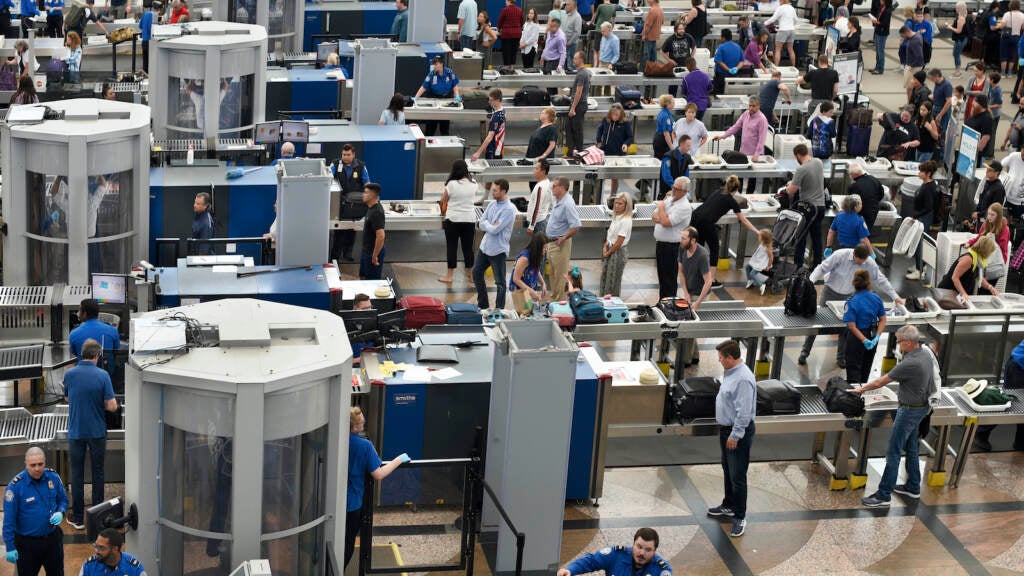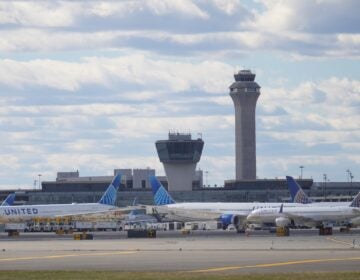Despite calls to improve, air travel is still a nightmare for many with disabilities

A man using a wheelchair hands his ID to an officer at a security screening checkpoint at Orlando International Airport in 2020. (Paul Henness/SOPA Images/LightRocket via Getty Images)
Anxiety, dread, humiliation — even potential injury. For many people with disabilities, these are part of the routine of airline travel, from getting to the airport gate to getting on and off the plane.
In 2018, Congress demanded that airlines and the Transportation Security Administration (TSA) make flying better for people with disabilities — but three years later, NPR has found, passengers report that the same problems keep happening over and over.
On a trip last year, Heather Leiterman, who is blind, was told by a TSA agent to take the harness, collar and leash off her guide dog, a black Labrador named Coastie. She explained to the agent that to do so would mean she’d lose control of the animal.
“That’s how they know they’re working. When the harness is on, they’re working. When the harness is off, that’s when they’re just a dog.”
But the agent insisted — even though the TSA’s own procedures say those items “do not require removal” for screening. “He was very hostile,” Leiterman says, and threatened not to let her on the plane if she didn’t comply.

When she called the TSA customer service line the next day, she says, the officer on the phone refused to take her complaint. “He said, ‘If the officer told you, you need to take this off your dog, you needed to take it off your dog.'”
“Stepping into an airport, I feel a sense of anxiety wash over me,” says college student Nathaniel Ross. “Not about making my flight or finding my gate, but for my inevitable interaction with the TSA that will leave me feeling dehumanized and criminalized because of my disability.”
Ross explains that he has “several physical disabilities” that require him to have implanted medical devices, including a feeding tube in his stomach and an intravenous line inserted under his chest wall.
Ross says the devices and the intravenous fluids he travels with often confuse agents. In 2019, when he was 18, he made multiple trips to and from Arizona and an Ohio children’s hospital for treatment. The bags of liquid — which need to be kept sterile and at a controlled temperature in a special container with ice packs — were X-rayed, opened and given an extended examination, he says.
Then, instead of putting each bag back into the cooling bag, the agent on one trip left them out, and Ross says when he and his mother asked the agent to please put them back, she refused and “we were scolded,” Ross says.
Ross was then subjected to a pat-down “of the two open holes in my chest and stomach” — in front of other passengers. Then, in private, he got a second more intrusive and “humiliating” pat-down “in all areas” of his body.
His story and Heather Leiterman’s experience are just two of the more than 225 responses NPR received to a social media call-out. We asked people with disabilities to share their experiences at airports; almost everyone responded with horror stories. Among them: wheelchairs broken in transit, airport escorts who never show up, children with autism separated from their parents at security gates and pat-downs that felt like sexual assaults.
Congress, in the 2018 FAA Reauthorization Act, told the airlines and the TSA to fix air-travel problems like these and demanded more training, better and faster service and taking better care of equipment, such as wheelchairs.
The act required the TSA to add training for how to handle the different needs of passengers with disabilities. One in four U.S. adults has a disability, according to the Centers for Disease Control and Prevention, and to understand various disabilities requires comprehensive and repeated training.
The TSA extended all training of newly hired TSA agents from two weeks to three weeks. That includes 5 1/2 hours of instruction on screening people with disabilities and medical conditions, according to a TSA official. Then, at work, agents and supervisors talk about how to respond to specific situations, including dealing with disability issues.
Still, most of the complaints that NPR heard from passengers were the result of agents not following that training.
In June, when Michelle Haag flew out of her Montana airport, she says agents were confused by what showed up in her body scan. “It’s my colostomy bag and my urostomy bag,” she explained. “I have cancer.” TSA agents pulled her aside for a pat-down in front of other passengers that left her crying and feeling humiliated.
Juniper Zayente, a college student with diabetes, was ordered to take off the pump that sends a steady flow of insulin into her body and put it through the X-ray machine — even though she told them radiation could damage the expensive device. The agent complained: “She said I looked too young to be using an insulin pump.”
One obstacle to better training: the high turnover of TSA agents, who, according to officials from the union that represents them, the American Federation of Government Employees, complain of low pay and lesser workplace protections than other federal agents.
And the agents’ primary focus is guaranteeing air security. There are stories of smugglers caught hiding drugs in wheelchairs.
“Our front-line officers have a very difficult job, period,” says Jose Bonilla, executive director of the TSA’s Traveler Engagement Division. Protecting “physical security” comes first, but he notes there’s a growing demand on agents to create a “culture of dignity and respect. And that’s something that we’ve been driving very hard.”
Congress also wanted more data collection to show how travelers with disabilities are treated. One key measurement: Congress told the TSA to count how long it takes passengers with disabilities to get assistance through screening procedures.
But three years later, the TSA has failed to comply with that part of the law.
Bonilla told NPR that the agency can’t do such a count because it hasn’t figured out a way to spot all passengers with disabilities — since many disabilities are invisible. But that shouldn’t stop agents from counting how long it takes someone in a wheelchair or with a visible disability who asks for help to get through.
‘A gauntlet of everything horrible’
The TSA does measure the growing popularity of its TSA Cares program. People can call in advance and be met by a trained airport agent who will escort people with disabilities through security. There were 14,674 requests for assistance in the program’s first year — fiscal year 2015 — and 27,711 requests in 2019.
Some people, like Jeff Stanford, said TSA Cares makes his family’s travel, notably a recent family trip to Disney World with his young disabled son, go “so wonderfully smooth.”
But as the use of the program grows, others have questioned whether the TSA can keep up, particularly at larger airports. Erin Mestas says she spent nearly two hours on the phone making an appointment, but when she and her 6-year-old daughter with Down syndrome arrived at the Denver airport in July, there was no one to meet them.
The TSA says the largest number of requests came for people with autism — who can find the noise and chaos of an airport difficult to handle.
Sarah Maxfield says that for her autistic son, going through airport security is “like a gauntlet of everything horrible for him.” TSA agents, strangers to him, yell orders, rush him, take his things from him to be screened and separate him from his family. TSA agents, she says, “are not exactly calm, kind, gentle or patient.”

There was one exception: an agent who took the time to learn the child’s “superhero name” — the name he prefers to be called — “and it made a huge difference.”
Sandra Zeigler, an autistic adult, explained that her audio-processing delays can make her slower to respond to spoken instructions from TSA agents. At airports, she’s repeatedly “yelled at” and “scolded in embarrassing manners” by agents and sometimes as a result, she believes, is pulled out for additional bag screening.
Now, she wears T-shirts to signal to agents that she’s autistic. “Autistic and Proud” says one. Another says “Autistic and Vaccinated” in bold letters and then, underneath, “No Relation.”
“The sad thing is that we have to ‘out’ ourselves to get that sort of understanding in stressful and overwhelming situations,” Zeigler says.
Check your wheelchair at the gate
Congress also ordered airlines to start measuring one of the most common problems — how often a wheelchair or motorized scooter is lost, damaged or destroyed in transit. The idea was that public accounting would put pressure on airlines to start doing a better job.
The numbers fell during the pandemic, as fewer people flew, but now they’re rising. In July and August, the last two months counted, about 26 wheelchairs and scooters a day were lost, damaged or destroyed — about the same as the monthly numbers in 2019.
“They don’t understand when they damage our chair, they’re basically stealing our car,” says Dan Formento, an Army veteran from Florida. “They’re taking our legs away from us.”
The loss of a wheelchair can even be dangerous. People close to Engracia Figueroa link her death to a series of events that unfolded after her wheelchair was damaged.
In July, she flew home to California from Washington, D.C., where the disability activist spoke at a rally to promote the expansion of home-care services. For people with spinal cord injuries, like Figueroa, wheelchairs are customized with special seating and other features to help prevent skin ulcers, which can grow rapidly and painfully and become infected. Figueroa spent weeks without her wheelchair as she and the airline clashed over whether United Airlines was responsible for simply making fixes to the $30,000 chair or replacing it — as it eventually agreed to do.
According to a doctor’s note reviewed by NPR, after a few weeks of being “forced to sit in a loaner chair” without proper cushioning, a previous bed sore that “was healing well” opened again. Hand in Hand, a group that advocates for domestic workers, announced that Figueroa died on Oct. 31 after multiple hospitalizations for the wound.
“We were saddened to hear about Ms. Figueroa’s passing,” a spokesperson for United Airlines said, “and we offer our condolences to her friends and family.”
Many people with disabilities told us about how air travel, for them, requires different strategies and more planning. For people who use wheelchairs, like Charles Brown, that includes calling airlines and the TSA in advance to get assistance.

Wheelchairs don’t fit on most planes or in jet bathrooms, so Brown, the president of Paralyzed Veterans of America, fasts and doesn’t drink before flying.
He doesn’t fly direct on long flights. He’ll schedule a stopover in another city in between so he can use the airport bathroom. He also makes sure he has a long layover to give plenty of time: for his wheelchair to be brought up from the plane’s baggage compartment, for him to get help being transferred into the chair and, finally, for him to have enough time to check it in for the next part of his flight journey.
Because the aisle of a jet is narrow, people like Brown need help from airline employees or contractors to lift them from their own wheelchair and into a smaller chair that can fit through the aircraft.
On a trip from his home in Florida to California in 2019, the men lifting Brown dropped him — onto the jet bridge.
“I’m a Marine. I’m stubborn,” Brown says. “I’ll fight through anything to take care of stuff.” But when he got off at his stopover in Dallas, he noticed the blood.
Days later, in pain from the fall, he went to the VA medical center. Doctors diagnosed a broken tailbone, and, worse, the wound had become infected. He stayed in the hospital for three months. There was surgery. He says he almost died.
But Brown, by law, couldn’t sue the airline. He could only file a complaint. He tried, after he got out of the hospital. But he says the airline told him he had waited too long to file.
‘When you think about air travel, it’s still 1986’
For people with disabilities, airline travel is regulated by an old — and people like Brown say — outdated law. The Air Carrier Access Act was signed into law by President Ronald Reagan in 1986.
In March, members of Congress introduced the Air Carrier Access Amendments Act of 2021, which would strengthen federal action against airlines that violate the rights of passengers with disabilities and would give those passengers a right to sue. It would also require aircraft to be redesigned to include safer storage of wheelchairs and to provide better access on the plane.
“When you think about air travel, it’s still 1986,” says Heather Ansley, Paralyzed Veterans of America’s associate executive director of government relations. “We haven’t really made any advances in accommodating people with disabilities.”
Other forms of transit are covered by the Americans With Disabilities Act, which passed four years after the law that regulates air travel. Ansley says there has been more improvement in access to those other means of travel, like buses. The ADA required them to be redesigned to include wheelchair lifts.
But on a plane, Ansley says, “there’s no place to bring on your wheelchair.” A September study by the National Academy of Sciences says most airplanes could be redesigned so that people could sit in their own wheelchairs and avoid the danger of being lifted in and out. The Transportation Department is working on a rule that could require larger lavatories on many planes.
At an October celebration of the 35th anniversary of the Air Carrier Access Act, Transportation Secretary Pete Buttigieg said there was a “moral imperative and an economic imperative” to make flying a more welcoming experience for passengers with disabilities.
Still, there’s a lot of work to make flying more dignified.
“People with disabilities are subject to inhumane treatment at every turn,” says attorney Katherine Macfarlane, who complained of “rough pat-downs,” TSA agents who tried to open medications that needed to be closed and sterile, and being forced to stand for long periods of time, which is hard for her to do because of her rheumatoid arthritis. “I’m dreading my next flight. I’m a lawyer and law professor who literally teaches and writes about disability law and have not figured out how to make it through TSA and fly safely.”
9(MDAzMzI1ODY3MDEyMzkzOTE3NjIxNDg3MQ001))




